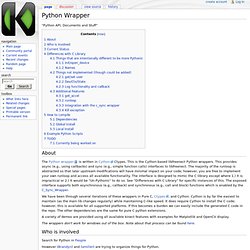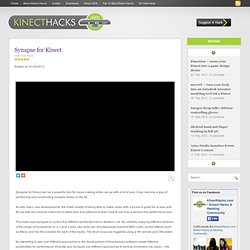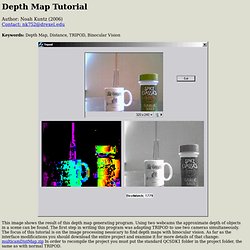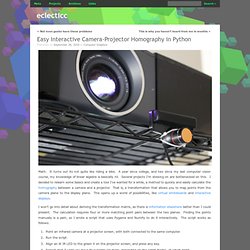

Creating a 3d printed model with KinectToSTL / Meshlab. OS X Issues - OpenKinect. Python Wrapper. "Python API, Documents and Stuff" About The Python wrapper is written in Cython Ctypes.

This is the Cython-based libfreenect Python wrappers. This provides async (e.g., using callbacks) and sync (e.g., simple function calls) interfaces to libfreenect. The majority of the runloop is abstracted so that later upstream modifications will have minimal impact on your code; however, you are free to implement your own runloop and access all available functionality. We have been through several iterations of these wrappers in Pure C, Ctypes, and Cython. A variety of demos are provided using all available kinect features with examples for Matplotlib and OpenCV display. The wrappers don't work for windows out of the box. Who is involved Search for Python in People However (Brandyn) and (amiller) are trying to organize things for Python. Current Status Differences with C Library Things that are intentionally different to be more Pythonic init/open_device In C: freenect_init(&ctx, 0) Becomes: ctx = init() Names.
Kinect Hacks - Supporting the Kinect Hacking news and community - Part 3. The Space Palette is a musical and graphical instrument that lets you play music and paint visuals simultaneously by waving your hands in the holes of a wood frame.

No prerecorded media, sequences, or loops are used – everything is generated in realtime by your hands. The wood frame is a reference for the player, while the Microsoft Kinect is used to detect the position of whatever hands (or objects) appear in the holes of the frame. The depth of your hands matters as much as their left/right/up/down position – it’s like having multiple three-dimensional mouse pads in mid-air. Any number of hands can be used. Musically, the large holes are like piano keyboards (left-to-right) on which you play individual notes, and hand depth controls things like vibrato and filters.
The 12 small holes in the corners of the Space Palette are used to select different sets of sounds and graphics. Depth Map Tutorial. Author: Noah Kuntz (2006)Contact: nk752@drexel.edu Keywords: Depth Map, Distance, TRIPOD, Binocular Vision This image shows the result of this depth map generating program.

Using two webcams the approximate depth of objects in a scene can be found. The first step in writing this program was adapting TRIPOD to use two cameras simultaneously. The focus of this tutorial is on the image processing nessicary to find depth maps with binocular vision. Easy Interactive Camera-Projector Homography in Python. Math.

It turns out its not quite like riding a bike. A year since college, and two since my last computer vision course, my knowledge of linear algebra is basically nil. Several projects I’m stewing on are bottlenecked on this. I decided to relearn some basics and create a tool I’ve wanted for a while, a method to quickly and easily calculate the homography between a camera and a projector. That is, a transformation that allows you to map points from the camera plane to the display plane. I won’t go into detail about deriving the transformation matrix, as there is information elsewhere better than I could present. Point an infrared camera at a projector screen, with both connected to the same computer.Run the script.Align an lit IR LED to the green X on the projector screen, and press any key.Repeat step 3 until you have four points (or more, depending on the script mode), at which point,The script will calculate the homography, print it out, and save it as a NumPy file.
Related Posts. The MacPorts Project.